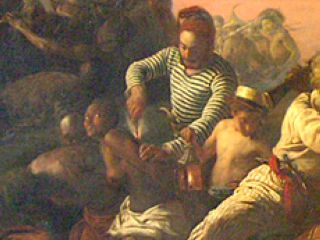The Slave Trade

For weggis. This detail of a female slave being branded with a red-hot iron on board a slave ship is taken from The Slave Trade by Francois Auguste Biard (1840). This painting is most unusual in being both a beautiful work of art and a powerful piece of propaganda. It also challenges the viewer, not in the sense of making it difficult for the viewer to comprehend the work, which is all too easy to understand, but in directly challenging the viewer's humanity. Biard's avoidance of melodrama increases the power of his visual message. No one bought this painting. So Biard gave it to an abolitionist.




6 Comments:
Ta! I am honoured.
In what sense are you using the word 'propaganda'?
In common usage [and I am a common man] it infers bias or falsity.
I would describe this work as a fine piece of art that reflects the artist's perception of reality. Whilst I have no objective proof that the historical record is accurate, neither do I have any reason, in this case, to doubt it.
We view this work from the perspective of the 21st century and with the benefit of hindsight. In 1840 this would have truly
shocked the comfortable classes, who by inaction were complicit in the subject matter, and who I suspect would have had their
heads buried in sand on such issues. Today most still have their heads in sand, only the detail has changed. The message is
as relevant today as it was then but I doubt many would see that. We don't brand slaves anymore, but our comfort is still underpinned by the misery of others.
You might be able to help me out here. Last time I went to the Tate [the proper one]there was a huge painting and I can't remember the name or artist. It was about 10 ft high and 20 ft wide and broken up into about 1 ft squares. Each square was subdivided into 4 triangles by diagonal lines and each triangle was a slightly different shade of brown to differentiate it from its immediate neighbours. I almost walked past it thinking what's it doing here.
If you stand in the right place so that the light catches it at the right angle a picture of a galleon at the dockside emerges complete with men unloading barrels, ie curves in a picture of straight lines. The image was in the texture of the paint.
Of course you won't find a photo of this, it wouldn't work.
Any ideas?
I knew somebody was going to quibble about propaganda! It's only nasty foreigners who do that sort of thing. We Brit's do "public information" films. Actually the word comes from 18th c. Italian and means "to promote the faith". It's based on the Latin: "Congregatio de propaganda fide" and it's what Roman Catholic missionaries do to those poor heathens in Africa. Did you know that one of the justifications for the slave trade was to convert savages to Christianity? What is so scary is that the poor devils swallowed it! The descendants of slaves might be free of their physical chains, but there's millions of them jumping up and down yelling "Hallelujah"!
Blogger seems to have got these comments out of order. Maybe it'll correct itself.
I'm afraid I can't help you with that picture you remember, but I can point out the earliest trick of that sort, in case you haven't come across it: Hans Holbein's The Ambassadors". It's in the National Gallery and it's amazing. The two ambassadors seem to have a loaf of bread at their feet - a French stick - and it's only when you foreshorten that loaf by looking along the painting that you realise it's a stretched skull! (Message: we are all mortal, even when we're dressed in our finery).
For more 3D illusions, try the website of Julian Beever, Pavement Artist: http://users.skynet.be/J.Beever/pave.htm. I'm hoping to write a blog on this artist soon, but haven't received a reply to my e-mail requesting permission to use one of his paintings.
Hallelujah!
----------------
Thanks for the ref. I will check it out. That Beever is incredible. The site says he's been to the UK.Huh! RAIN!
Beever's Princess Di is very good. I think I'll write that blog soon, with or without permission. His 3D stuff is clever.
Post a Comment
<< Home